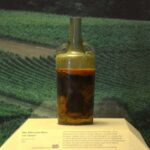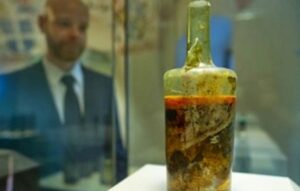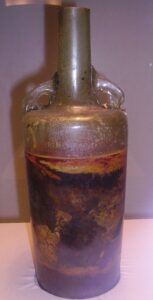
 Most people know that wine gets better with age, but I wonder if there is a limit to that statement. Some wines, I’m told wine can be aged for 10 to 20 years, but there really is a limit. In a Roman tomb in Germany in 1867, a bottle of wine was found that is believed to date back to 325 – 350 CE. The oldest bottle of wine ever found. Those who found it, named it Speyer, for the city of Speyer, near where the bottle was found. The bottle was discovered during an excavation of a 4th-century AD Roman nobleman’s tomb. The tomb contained two sarcophagi, one holding the body of a man and one a woman. It was a very unique bottle, with dolphin-shaped handles, and it is sealed with wax and olive oil. I’m sure that was the hope that by so preserving the wine, that it would be able to be used later, but then it was found in a tomb, so I’m not sure of the actual purpose. There were several other bottles found with the Speyer bottle, but they were all empty or broken.
Most people know that wine gets better with age, but I wonder if there is a limit to that statement. Some wines, I’m told wine can be aged for 10 to 20 years, but there really is a limit. In a Roman tomb in Germany in 1867, a bottle of wine was found that is believed to date back to 325 – 350 CE. The oldest bottle of wine ever found. Those who found it, named it Speyer, for the city of Speyer, near where the bottle was found. The bottle was discovered during an excavation of a 4th-century AD Roman nobleman’s tomb. The tomb contained two sarcophagi, one holding the body of a man and one a woman. It was a very unique bottle, with dolphin-shaped handles, and it is sealed with wax and olive oil. I’m sure that was the hope that by so preserving the wine, that it would be able to be used later, but then it was found in a tomb, so I’m not sure of the actual purpose. There were several other bottles found with the Speyer bottle, but they were all empty or broken.
Of course, given the age of the bottles, no one will ever drink the contents. It would not be safe, so the exact contents remain unknown. Nevertheless, archaeologists believe the liquid inside was made from grapes planted in the region. The Speyer wine bottle (Römerwein in German) is a sealed bottle that is will not been opened to check the contents. Even without verification, it is considered the world’s oldest known bottle of wine. Since the discovery of the bottle, it has been exhibited at the Wine Museum section of the Historical Museum of the Palatinate in Speyer. The “Römerwein” is housed in the museum’s Tower Room. It is a 51 US fluid ounce glass bottle with amphora-like “shoulders” that are yellow green in color and with dolphin-shaped handles.
It is thought that the man in the tomb was a Roman legionary, and the wine was a provision for his journey to  Heaven. People had some strange customs back then, and some may still have. Of the six glass bottles in the woman’s sarcophagus and the ten vessels in the man’s sarcophagus, only one still contained a liquid. There is a clear liquid in the bottom third, and a mixture similar to rosin above. While it has reportedly lost its ethanol content, analysis is consistent with at least part of the liquid having been wine, although I’m not sure how they made that analysis without opening the bottle. The wine was infused with a mixture of herbs, but the preservation of the wine is attributed to the large amount of thick olive oil. Since I’m not a scientist, I’m not sure how that would work, but apparently it did, as it was added to the bottle to seal the wine off from air, along with a hot wax seal. The use of glass in the bottle is unusual, however, as typically Roman glass was too fragile to be dependable over time.
Heaven. People had some strange customs back then, and some may still have. Of the six glass bottles in the woman’s sarcophagus and the ten vessels in the man’s sarcophagus, only one still contained a liquid. There is a clear liquid in the bottom third, and a mixture similar to rosin above. While it has reportedly lost its ethanol content, analysis is consistent with at least part of the liquid having been wine, although I’m not sure how they made that analysis without opening the bottle. The wine was infused with a mixture of herbs, but the preservation of the wine is attributed to the large amount of thick olive oil. Since I’m not a scientist, I’m not sure how that would work, but apparently it did, as it was added to the bottle to seal the wine off from air, along with a hot wax seal. The use of glass in the bottle is unusual, however, as typically Roman glass was too fragile to be dependable over time.
Scientists have considered opening the bottle to further analyze the contents, but as of 2023 the bottle has remained unopened, mostly because of concerns about how the liquid would react when exposed to air. The museum’s curator, Ludger Tekampe has stated he has seen no changes in the bottle in over 25 years, so whatever they are doing to preserve it is working. It seems to me that scientists would be remiss in their care of this bottle by opening it for no good reason. I think it should be left as is.


Leave a Reply